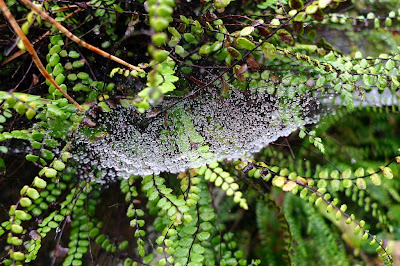September made something good on the disappointing summer, with mostly dry weather and several lovely Indian summer days under strikingly blue skies. Why is it called “Indian summer”? The expression in German is Altweibersommer” (old women’s summer) which is associated with the spider webs that you find everywhere at this time in the mornings. It is said that "weiber" didn''t really mean women in old German, but rather "weave", or making a net or web.
-1.JPG)
.JPG)
October had some lovely days as well, and moderate rain so far. The last days were grey under fog, however.
I filled in the October gap in A Stitch a Day, one pattern has still to be done though. Doing this reminded me of my visit to Germany a year ago, and of the colourful autumn there with all sorts of yellows and reds and combinations of them in the leaves of trees in gardens, villages and forests, and in the vineyards. I realised once again that we don’t have this colourful ceremony preparing us for winter here.
Does the reason lie in the type of trees, or is it the dampness of air and ground that prevents it?
Anyway, I took the camera to catch some of the autumnal features around my place. Here is the path to the pasture, which is the most of a “leaf walk” I can get. Ash, willow and hawthorn leaves are collecting there. A faint yellow is the most of colour they show, quickly turning into brown.
I filled in the October gap in A Stitch a Day, one pattern has still to be done though. Doing this reminded me of my visit to Germany a year ago, and of the colourful autumn there with all sorts of yellows and reds and combinations of them in the leaves of trees in gardens, villages and forests, and in the vineyards. I realised once again that we don’t have this colourful ceremony preparing us for winter here.
Does the reason lie in the type of trees, or is it the dampness of air and ground that prevents it?
Anyway, I took the camera to catch some of the autumnal features around my place. Here is the path to the pasture, which is the most of a “leaf walk” I can get. Ash, willow and hawthorn leaves are collecting there. A faint yellow is the most of colour they show, quickly turning into brown.

I found the ewes already expecting my husband with the feed bucket. See how they ignore me this time? They took me as sign and promise that my husband would follow with the feed, looking behind me down the path where they expect him to appear. They had to wait a while longer. I was early.

Meanwhile I took this foggy picture of Dowra.

Along the path I had noticed earlier a pleasant smell as if emitted by flowers. I hadn’t realised first where it came from. I suppose not all people would recognise the flowers in the foreground here, appearing at an unusual time for shrubby plants:
Yes, it was the smell of ivy flowers that my nose had detected. They are only found on old plants. The leaves of these don’t show the stereotype shape commonly associated with ivy. Sheep love ivy leaves. Sometimes I harvest ivy that grows up trees trunks for them, by tearing off the woody stem in the hope that it comes off with everything attached, and the mass of leaves higher up in the tree falling down on me eventually. It doesn’t always work, though. Sometimes the woody stem just breaks.
Red colour? I found it here in holly berries. I don’t know why they are associated with Christmas. Every time I looked for them for Christmas decoration in December they had disappeared.
Here is an autumnal scene in the corner of a field with red rose hips.

Red, orange and yellow are hidden under a shrub, displayed by the fruits of the Pitcher Plant. Fly catching must have been successful here in some instances.


I can’t remember where I read that opening up the flowers at flowering time and looking at what you see there, can forecast the whether and harvest for the year.
Japanese anemones are my autumn garden flowers. They keep flowering for a long time. I’m always amused by all their “bobbles”. The flower buds are bobbles, so are the ovaries and seed heads. See a collection here:







What a beautiful picture you tell of your surroundings. Its nice to see your sheep too - they have lovely handsome markings on their faces!
ReplyDeleteI have noticed the ivy flowering also, and covered in buzzing insects too.
xx
c
I noticed the insects as well. And I feel I've never seen that amount of flowering ivy in other years.
ReplyDelete